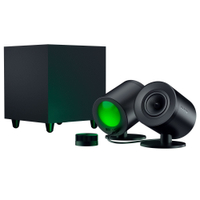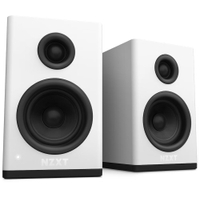Best speakers for PC gaming in 2024: from 2.1 systems to bookshelf bangers, these are the best I've tested
Treat yourself to an awesome audio experience with the best PC speakers.
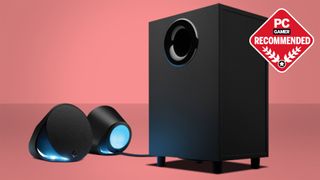
We've been blasting the best PC speakers all day and all night to find out if they've got what it takes to earn a place on our desks. Sure the best gaming headsets will give you a more intimate immersion, but there's nothing like enjoying your audio out loud with the best PC speakers.
The best PC speakers overall are the Logitech G560, as they deliver great sound and look pretty funky while doing it, too. The best budget speakers are the Creative Pebble Plus units, which make up a small yet surprisingly powerful package for very little cash.
If you have the space under your desk then you should go for the typical 2.1, left/right speaker setup with a subwoofer on the floor. But there's also PC soundbars to consider, which have made a punchy comeback recently that puts excellent depth of sound and positional audio on your desktop. Below you'll find my top recommendations for loud, reliable PC speakers and soundbars for your desktop.

Andy's got a background in audio engineering and has had the pleasure of sitting in front of some of the best speakers money can buy, so he's well qualified to tell you which can give you the best bang for your buck.
The Quick list
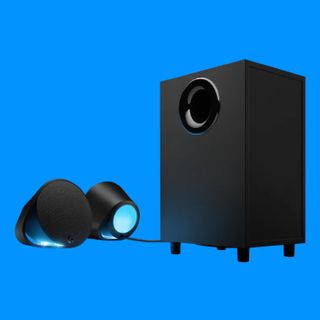
The best overall
The Logitech G560s don't just sound great, but with immersive RGB lighting they look the part, too. They're true all-rounders, with great bass response and built in DTS:X Virtual Surround support for an all-encompassing sound.
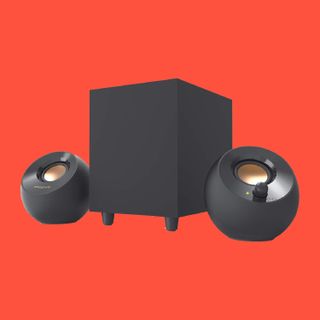
The best budget
They might be cheap, but you're getting a huge amount of sound for your money. The bass isn't earth-shattering, but with excellent clarity and a small footprint you can squeeze these clear performers in almost anywhere.
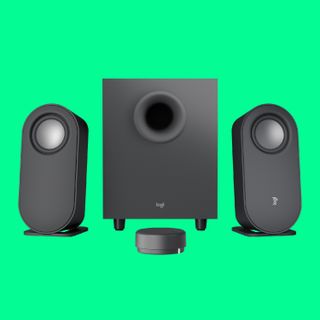
The best mid-range
While they might not have the "look at me" RGB lighting of their bigger brothers, the Z407s still offer great audio quality with the addition of a handy wireless control knob, all for a very reasonable price.
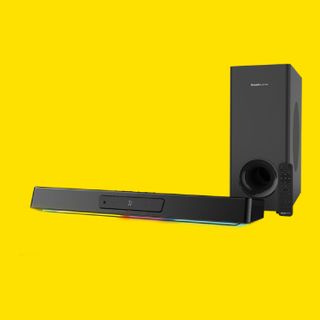
The best gaming soundbar
A well-designed soundbar solution, which was designed to prioritise PC gaming audio. That being said, with plenty of connection options, RGB lighting and a substantial sub, it's got plenty of flexibility for all sorts of uses.
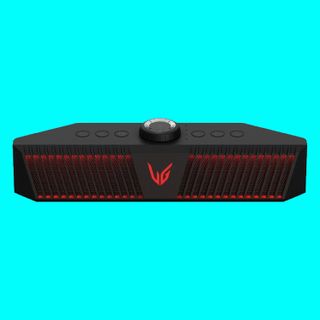
The best wireless soundbar
With good battery life and great surround sound, the LG UltraGear GP9 makes for a fantastic, if very pricey, wireless PC soundbar solution.
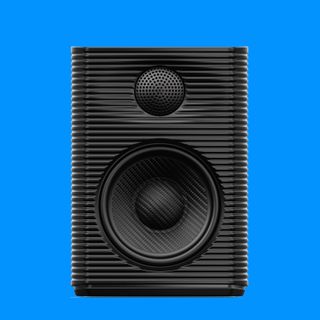
The best bookshelf speakers
This pair of chunky speakers offers a rich, smooth tone. It keeps games and music sounding their best, and delivers a hearty bass response, even without a subwoofer.
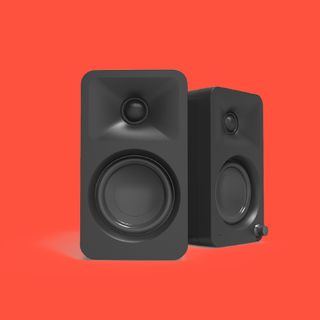
The best reference speakers
These aren't cheap, but the sound quality here is exceptional, and they're remarkably powerful too. If you're looking to splash out a little on high-quality audio, these little units really kick.
Recent updates
Updated April 22 to switch to our new guide format and to add in the Majority D80s and Kanto Ora speakers, and to check over all our other recommendations.
The best gaming PC speakers




Specifications
Reasons to buy
Reasons to avoid
✅ If you're looking for the best all-rounders: Thanks to some balanced audio, a great subwoofer and virtual surround support, the G560s are great at, well, just about everything.
✅ If you like a bit of RGB: The Lightsync RGB lighting might not be to everyone's taste, but the ambient responsive glow it creates is a nice addition.
❌ If you're on a budget: The G560s aren't the cheapest options, although you are getting a lot of versatility and power for your money.
The Logitech G560s provide a well-rounded combination of satellite speakers and subwoofer that's so versatile and well thought out, they have to be our best PC speakers overall. Not only do they sound great, but they also look great too, and are ideal if you want to ditch the gaming headset for a while and play it fast and loose with your volume dial.
The audio quality and clean-cut design have these speakers stand out among the crowd. I love how they sound out of the box, but you can also tweak them within the Logitech G Hub app. There's a lot of bass on offer, but the tweeters are just as capable of throwing out excellent audio. You can really crank these speakers up to 11 if you want to, though even at low volume levels they still spit out quality sound. That used to be a bit of an issue with these speakers admittedly, as they wouldn't output low volume even on their lowest settings, but that was fixed a long time ago with a firmware update.
Chances are you either love or hate RGB lighting. The PC Gamer office is generally divided on this topic too, but there's one thing we can agree on: Logitech's G560 Lightsync feature is anything but gimmicky. If there's one RGB product I can recommend that will impact your PC gaming experience, this one.
Logitech's software allows you to choose between two control modes for the speakers. Hardware control ditches the software and uses Bluetooth or AUX input for lighting. You get a gentle rainbow color cycle that acts as an audio visualizer, which flashes and brightens to the music's beat. The software control allows you to choose between fixed color, color cycle, breathing, audio visualizer, and screen sampler lighting modes.
The screen sampler, however, is where the G560 shines. Like ambient TV backlighting products, the software takes user-defined screen areas. It extends the colors outwards to create an immersive lighting experience like Philips' Ambilight tech on TVs. Since a good portion of this effect relies on the rear-facing LEDs, the speakers need to be positioned beside your display with their back against a wall to get the best result. Get it right, though, and the effect is incredible.
We love the Logitech G560's powerful audio and surprisingly refined RGB lighting. If both of those sound good to you, these are the best of the bunch, although it you're looking for something cheaper, then the Logitech Z407 set below are well worth your time.
Still, one must win, and the G560s sit at the very top of our recommendations for a reason. The best overall PC speakers? Right here.
Read our full Logitech G560 review.
The best budget PC speakers



2. Creative Pebble Plus
Our expert review:
Specifications
Reasons to buy
Reasons to avoid
✅ If you're on a budget: Normally we yell "how much" when we spot something pricey. Here, we yell it because the Creative Pebble Pros are remarkably cheap.
✅ If you still want great audio clarity from cheap speakers: While they aren't particularly bass heavy, the Pebble Pros are very clear and distinct in their delivery, which makes them perfect for a spot of YouTube watching or for dialogue heavy media.
❌ If you like a lot of bass: Despite the included subwoofer, the Creative Pebble Pros don't quite have the gumption to provide room-shaking low end fun.
When you're out shopping for PC speakers on a budget, it's easy to be overwhelmed by choice. It doesn't help that reliable brands have multiple options in the same price range. The low-end differences can be minimal, but the Creative Pebble Plus speakers stand apart from the competition with their big sound despite the compact size. That makes them my pick for the best budget speakers, as nothing gets close to their level of quality for the money.
With a total power output of 8W, I found that these speakers pump out crisper audio more than competitors using two to three times the power amount. They won't produce the loudest sound around, but I heard little distortion even with the volume maxed out, and at more reasonable volumes they get the job done well. The only complaint here is a lack of bass control to complement the convenient volume knob located on the right speaker.
The Pebble Plus speakers may lack some raw oomph, but they make up for it in clarity. This is why we highly recommend these speakers for students and those who move around a lot, as the speakers are small enough to fit on any cramped desk surface. They're easily the most portable system I tried and performed best in a smaller bedroom or office.
Like any other pair of speakers at this sort of entry-level price range, the Creative Pebble Plus speakers are easily shamed by a mid-range set like the Logitech Z407. You are missing out on wireless connectivity, and there are lots of fiddly, easily tangled wires to deal with if you're moving around a lot. However, these speakers are the clear winner for gamers on a tight budget.
The mid-range PC speakers


3. Logitech Z407
Our expert review:
Specifications
Reasons to buy
Reasons to avoid
✅ If you want powerful sound for a lower price: At a $110 MSRP, these are loud and distinctive speakers for less than you might expect.
✅ If you want wireless control: The hockey puck like wireless volume knob is a great feature, and adds some real flexibility to your speaker setup.
❌ If you need lengthy cables: The included cables here are a little short, which is a shame if you were planning on spacing the speakers some distance apart.
If you don't want to stretch your budget to the flashier Logitech G560 speaker set, the company's much more tame Z407 set offers a great alternative for less money, and are our top pick for mid-range speakers. They're effectively a similar set of two tweeters and a subwoofer but ditch all the gamer stylings and lights of the fancier kit.
The Logitech Z407s pretty much win the award for most deceptively awesome computer speakers around. This 80W speaker system connects via Bluetooth, 3.5mm headphone jack, or Micro USB, so you can easily connect to them with your phone, gaming laptop, or PC. Keeping with the wireless theme, I fell in love with the wireless control knob, which let me control my media with satisfying spins.
That's one of the key benefits over the much cheaper Creative Pebble Plus, but don't ignore their simple and effective design. The Logitech's two tweeters come with small stands for your desk, and the subwoofer is compact enough to not take up to much space under your desk.
What was not satisfying was the unusually short 4ft cables, which limit how you can set them up. However, being able to lay the speakers vertically or horizontally is a nice touch. The sound achieved surprisingly balanced audio for a speaker set asking for this much cash—a strong yes for anyone looking to upgrade their current dinky desktop speakers.
The best gaming soundbar




4. Creative Sound Blaster Katana V2 Soundbar
Our expert review:
Specifications
Reasons to buy
Reasons to avoid
✅ If you want versatility: With a plethora of connectivity options and a flexible sound that suits many purposes, the Katana V2 aims to cover all bases, and mostly succeeds.
✅ If you want a soundbar with powerful bass: Thanks to the addition of a subwoofer, this setup packs a mean punch.
❌ If you're going to primarily use Bluetooth: While we had some issues with the Bluetooth connection, it did sort itself out eventually, but might be a sticking point if that's your primary concern.
❌ If you're on a budget: At a $350 MSRP this is not a cheap setup, and if you're just looking for great audio they might be a bit more than you really need.
It's been a while since we had a soundbar on this list. Mainly because many soundbars out there are tuned and made for TVs and not PC gaming. Often, the soundbar is too big for your desk or too small, and the sound lacks any oomph. However, that's not the case here, and the Sound Blaster Katana V2 earns a top spot among computer speakers during our time testing it.
The Sound Blaster Katana V2 is a significant upgrade from last year's model with a sleeker look and, more importantly, better-sounding tweeters and subwoofer. They're well placed to face your ears while gaming at a desk and pretty powerful.
The subwoofer's 5.25-inch driver provides the V2 that little kick in the butt you want when you playing shooters and still have a decent enough soundscape for listening to music. Thanks to its many connectivity options, it can also be plugged into pretty much anything you own, which separates it from the Razer Leviathan soundbars we've tested that are more limited on connectivity.
You are sorely mistaken if you thought this soundbar would miss out on RGB lights, however. The Katana V2 has bright RGB lighting that accents the bar's underside and adds a little flair. Though this is quite a large unit for any desk, it might be a tight fit if you don't have much room to spare for the near 24-inch soundbar.
The downside to the Katana V2 is the hefty $350 price tag, which makes it more expensive than most gaming soundbars you can buy right now. Another problem was setting up premium features like SXFI, and Battle Mode has to be set up through a cumbersome app. Some nagging odd Bluetooth connectivity issues were also a bit of a pain, but ironed themselves out eventually. Weirdly enough, the fix was cycling through different inputs every time.
The Sound Blaster Katana V2 is a great soundbar all things considered. It's small enough to sit comfortably on a decent-sized desk without taking it over and loud enough to easily be featured as your living room sound system. While it's not wireless like the LG UltraGear GP9, it's got enough heft and flexibility to stand out amongst the crowd, which makes it the best soundbar we've tested so far.
The best wireless gaming soundbar





5. LG UltraGear GP9
Our expert review:
Specifications
Reasons to buy
Reasons to avoid
✅ If you want a soundbar that's loud: There's plenty of volume on offer here, and the automatic gain control keeps things distortion free.
❌ If you want something very compact: It's not the biggest soundbar unit in the world, but it is pretty bulky. It should squeeze between most monitor stands without issue, but it stands a little tall and goes a fair way back into your desk, too.
At a glance, it's easy to mistake the GP9 as just a standard gaming soundbar. It's way more than that. For starters, one of its many tricks is that the GP9 can act as a wireless speaker with around 5 hours of battery life. So this means you can drag this small speaker right to the living room and give your TV a sound boost (assuming it's Bluetooth) or connect your phone and enjoy some tunes outside.
The tiny three-pound, 15-inch speaker, does a fantastic job of producing virtual 3D surround sound using its FPS mode setting. If it is late and you can't blast audio, the speaker will output 7.1 virtual surround sound to any headset you plug into it with a 3.5mm headphone jack. It plays nice with multiple devices and consoles, and an easy-to-understand smartphone app does all your customizations like RGB lighting and EQ options.
Another feature you won't find in other entries on the list is that this Bluetooth speaker has a built-in mic for voice chat. Between work calls and Discord chatting, my voice was clear and sounded good. If you're someone who hates wearing headsets all day, it's a nice feature.
However, I did find myself having some difficulties trying to parse between voice chat and the sounds of gunfire and zombie death gargles during more hectic sessions of Back 4 Blood. When things get wild, it's hard to hear your teammates let alone try to have a conversation with them without feeling like you need to scream to be heard despite its in-game sound-canceling working its best.
While wireless is a great feature to have in a soundbar, if you're not too fussed then you could check out the Creative Sound Blaster Katana V2 Pro. It ditches the wireless option in favor of a honking great subwoofer, for some real room-rumbling action.
The GP9 pretty much does everything and then some, which would explain the super-high price point. The built-in microphone is nice, but I don't see it replacing a headset/microphone combo for team games that require a little more coordination.
Still, can't have everything, ey? That doesn't stop the LG UltraGear from cranking out some great audio, and if wireless soundbar flexibility in combination with sonic chops is what you're after, this is the best we've tested.
The best bookshelf speakers







Specifications
Reasons to buy
Reasons to avoid
✅ You want rich audio: the SP3 BT shines across all manner of content, be that games or music.
❌ You want more low end: the SP3 lacks some oomph in the low-end versus some gaming speakers, which are known for kickin' bass.
Looking for the best bookshelf speakers? You'll want the FiiO SP3 BT. Within ribbed cabinets sit a pair of speakers, a 1-inch tweeter and 3.5-inch midwoofer, able to generate rich and enticing audio for both games and music.
With various options for connectivity on the FiiO, across wired and wireless, you'll be able to put them to good use no matter what you intend to use them with. Obviously, they'll work great as a backup to your gaming PC, sat proudly on your gaming desk on either side of your monitor. Though you could just as easily put them up on a shelf and connect via Bluetooth to your phone for some casual tunes or, dare I say, a party?
If you do connect via your phone, you can also employ the aid of the FiiO app to apply an EQ and update the firmware. Otherwise, volume is controlled via a small dial on the rear, as is the bass response.
In our review, which you can read at the link below, we described the audio outta these cabinets as "sublime" and "crisp and clear". All good adjectives for speakers, I assure you. Whether tested through listening to some proper bops or playing some games, the SP3 delivers surprising amounts of low-end oomph for a speaker without a subwoofer.
While we wouldn't call the SP3 small, by any means, the lack of subwoofer does mean fewer cables to mess with if you're moving these around frequently. That shouldn't be an issue for these speakers, either, as they're made from die-cast aluminium.
While you can purchase competitive gaming speakers at this sorta price, we really appreciate the crisp audio that the SP3 delivers. It's a precise, clear, and excellent sound profile. Also, you won't miss out on extremely important gaming features such as RGB lighting, which the SP3 offers around its base.
Read our full FiiO SP3 BT review.
The best reference speakers




Specifications
Reasons to buy
Reasons to avoid
✅ If you want immensely detailed sound: These are reference speakers, which ordinarily means they'd sound a little flat for casual listening. Not so here.
✅ If you want an understated look: These are serious, professional looking speakers, and should blend in no matter where you put them.
❌ If you're not prepared to pay up: $350 is a lot of money for speakers, although it has to be said, not a huge amount for reference units. Still, for regular usage that's quite a bit to spend.
❌ If you don't have the cables: Cables are cheap, it's true. Still, it'd be nice if Kanto included some in the box, other than the one that links the two speakers together.
The Kanto Ora speakers are rather ordinary looking. For some that's going to be a bonus, and for others something of a let down given the $350 price tag. However, that flat black aesthetic betrays the fact that these speakers are not out to impress with their looks, but are instead designed to blend in to a studio setup. All that really matters in a studio environment is sound, and audio quality is where the Ora set really shines, which makes them the best reference speakers you can buy for this sort of money.
Don't let the relatively small size fool you—the Kanto Oras can put out some serious bass, and massive amounts of volume too. More than that, they're detailed in a way that should allow you to hear not only the nuances of your favorite tunes, but also positional audio and ambient noises in your games too.
Being reference speakers, these units are designed to deliver what's there, and not mollycoddle the sound into becoming something that it's not. Often that can lead to a flat, lifeless sound, but the Oras have just enough user-friendly magic sprinkled on top of their driver design to ensure that you end up with the best of both worlds, a fantastically accurate sound which still sounds pleasing to your ears.
And for the money, they'd better. Still, reference speakers are not cheap, so they actually represent excellent value for the level of audio quality they're able to fire at your eardrums, and with this much volume on top, potentially your neighbors ears too. Still, if the Oras are too rich for your blood and you still want great audio from two speaker units, I'd suggest taking a look at the Majority D80 set above.
Connectivity-wise, you've got the option of USB-C, RCA or Bluetooth. That's a greatest hits line up right there, although with one major omission, and that's a 3.5mm aux input. Still, that wouldn't be a problem with the addition of a very cheap 3.5mm to RCA cable, which is why it's baffling that it doesn't include one, or indeed, any cables at all. Well, apart from the one that connects the two speakers together, anyway. That'd be really silly not to include.
Still, the Kanto Oras sound fantastic, and really, that's all they aim to do. If you're looking for pure gaming audio only they're probably a bit much for your purposes, but if you want speakers that can do it all, and do it with just about the best audio quality you'll find outside of a studio environment, well, these are probably exactly what you need.
They're the best reference speakers we've tested to date, and despite the cost, that makes them some of the best speakers you can plug into your PC, too.
Read our full Kanto Ora review.
Also tested
Razer Nommo V2 Pro| March 2024
"With the puck, Razer Synapse, and the subwoofer's bass being a tad loud at the start, there's a lot to get used to with the Razer Nommo V2 Pro but, once you invest the time, it really pays off. "
PC Gamer score: 80%
NZXT Relay system | March 2024
"The NZXT Relay set is a bit of a tech wonder, but only if you buy all the accessories. If you don't, it's a bit of a mess—but a very creative one at that."
Q&A
Do I need a 2.1, 5.1, or 7.1 setup?
You'll mostly find 2.1 setups for the PC market covering just left/right channels and a subwoofer—perhaps more often than that, even devoid of a subwoofer for a 2.0 setup. That's mainly because that fits the bill for a desktop and monitor, with the speakers in front of the user for decent stereo sound.
Living room speaker setups and home cinema systems will take that a little further, often offering at least five surrounding speakers in most cases. You could hook such a system up to your PC and find decent support for such a configuration, but we're hesitant to recommend such a setup due to the sheer number of wires involved around a single desk. It doesn't bear thinking about.
Some companies will tout virtual 5.1 to make up for the lack of physical speakers, often at the expense of sound quality, including Windows' Sonic function. Don't forget many games use clever 3D audio techniques to generate positional game audio with great accuracy, so you may find you don't need much of a helping hand.
Which is better, speakers or soundbar?
Since both speakers and soundbars can offer a similar audio experience, it all comes down to your desktop. If you've little space to spare, a pair of computer speakers will be best suited. Whereas a soundbar can take up a long stretch behind or under your monitor. That said, a soundbar can work a treat with monitors on arms or mounted off the desk.
The other thing to consider is that a soundbar might offer some extra features, such as beamforming or head-tracking, or come with a few more smaller tweeters than a standard 2:1 speaker set. But generally, it comes down to space as to which is best.
How do we test computer speakers?
We tested each set of speakers in-game for several hours through a wide range of games with rich soundtracks and sounds, including Doom Eternal, Call of Duty: Warzone, Counter-Strike: Global Offensive, Overwatch, and Hellblade: Senua's Sacrifice. Afterward, we ran listening tests, which included snippets from the film Jurassic World and various albums in lossless FLAC format, such as Daft Punk's Random Access Memories and Psychic from Darkside.
One of the most important features to test for was the left/right balance with gaming in mind. To check this in-game, we used the CS: GO Audio Test Chamber workshop project by geri43. It's a simple tool that allows you to reproduce all sorts of in-game sounds, including ladder movements, sniper scopes, gunfire, footsteps, and more. Moving around the map or behind a wall allowed us to manipulate the sounds' location and test how easily we could identify their direction with the speakers.
The biggest gaming news, reviews and hardware deals
Keep up to date with the most important stories and the best deals, as picked by the PC Gamer team.

Andy built his first gaming PC at the tender age of 12, when IDE cables were a thing and high resolution wasn't. After spending over 15 years in the production industry overseeing a variety of live and recorded projects, he started writing his own PC hardware blog for a year in the hope that people might send him things. Sometimes they did.
Now working as a hardware writer for PC Gamer, Andy can be found quietly muttering to himself and drawing diagrams with his hands in thin air. It's best to leave him to it.
Most Popular



